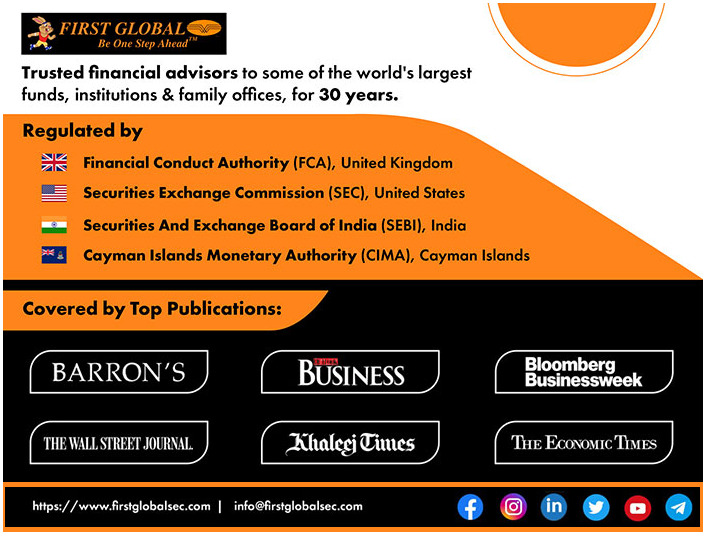“One has to look at export or import substitution sectors, particularly in line with the PLI scheme. There will be some pockets in chemicals, capital goods, auto and auto components. We do not like the two-wheelers for instance but there will be some pockets in the auto sector and one has to be choosy now," says Devina Mehra, Chairperson & MD, First Global.
It has been a good year and seems it is about to become a grand year with the rally that we have seen in the last couple of days both locally and globally. What is in-store for 2022?
Yes it has been a pretty decent year. The last I saw the Nifty was up some 22% and NSE 500 was up 28%; of course, we are up 52% for the year and so that has certainly been a great year for us. But going forward it looks like a pretty decent year ahead even in terms of the headline numbers, subject to the news on virus.
As I have said before, normally the apprehension is whether there will be a big crash and normally the track record of any market usually is that the big crash happens when one is very far above the trendline. We have had pretty decent two years. But if one goes back further, 2019 was not great, 2018 was actually a down year and even if one looks at the 10-year period from 2010 to 2020, we were compounding only at about 8.5% which was the fixed deposit rate at that point. So there was that room. We were very much below the trendline. We are still not at the trendline, let alone be very, very high. So the big risk is not there as far as the headline numbers for the market are concerned.
There are risks elsewhere, which is more to do with the macroeconomic front. There are some currency and inflation risks for India and in different ways, globally. At least, on the inflation front for the first time, the developed markets have had to look at inflation. Otherwise, inflation was a background number for them.
Of course, that is not the case for the emerging markets, or for India. Inflation comes into focus very often but where we are today, I would keep my eyes on the macro numbers and, of course, within India, sectorally itself, let alone in terms of stocks, there is a lot of dispersion. The FMCG index is up 8% for the year. Nifty Bank is about 11% or so up whereas a bunch of sectors like IT, metals, capital goods and some other commodities and materials are up 50-60% or even higher. I am talking about just the sectoral indices. In 2022, it will depend on where one is in terms of sectors and companies.
So where should one be according to you? Also, if I have to take the trendline theory forward, I am sure for IT and metals, the trendline has to normalise towards downside rather than on the upside?
In the middle of 2020, we made a call on IT at a time when FMCG stocks were greatly in favour. It is not just the trendline; one has to look at many things. There my call was that there was this sector – IT – which has pretty decent return ratios like FMCG, although not quite so high, and that is predictable in a very uncertain world, gives you a currency hedge and yet the valuations were a fraction of what FMCGs were trading at. That was a re-rating story.
In terms of macroeconomic variables, from the government side or from a central bank or any policymaker side, one would like to have high growth, low unemployment, low inflation, low interest rates and a strong currency. These are the objectives but it is not possible to pursue all those objectives at the same time. It is like trying to stuff five things into a box which can contain only three things and when you stuff in everything, something pops out from the other end.
So what is happening now is that the RBI has decided to focus on growth because economic growth, especially below the top tier is still hurting. Even in terms of the citizens, in terms of whether they have jobs and what their incomes are, the situation below the upper tier is not so good. The wholesale price index is at a high of about 20 years and yet we have decided to hold on to the interest rates. It has not yet shown up in the consumer price index but that happens with a lag. So we have decided to hold on to the interest rates and people sitting in India think that we are holding on to the interest and the whole world has also not raised interest rates because for us the only two markets we look at are India and the US.
Neither the Fed nor India has raised rates yet. But if one widens the horizon and looks at all emerging markets or the rest of the developing world, central banks have raised interest rates not just once but twice, thrice, even five and six times. From Brazil to Russia, we have seen rate hikes everywhere. India actually is an outlier in the emerging market pack as we haven’t raised interest rates despite high inflation. That is likely to cause a strain on the currency.
The third factor is that if we look at the long-term chart of the rupee against the dollar. Either the Rupee depreciates slowly – 2% to 3% every year – or has periods when for years, it is in a band and then there is a sudden step down when rupee depreciates. We have been in the 73 to 75-75.5 band for a long time. All these things point to a possible strain on the currency, I mean all things are only in terms of probability but I would say that this is a year where I would expect rupee depreciation.
Therefore it is a good place to be in an export oriented or an import substitution kind of a sector. So we continue to like IT as a sector for now.
As I said, I never make a one-year projection but while metals and for that matter, power and energy were great through the year and we have ridden that, the story had started to taper off a little while ago. Right now I would say they are like more market performer kinds of sectors rather than being very great. IT continues to be good. Selectively, one has to look at export or import substitution sectors, particularly in line with the PLI scheme. There will be some pockets in chemicals, capital goods, auto and auto components. We do not like the two-wheelers for instance but there will be some pockets in the auto sector and one has to be choosy now.
You have always advised against putting all your eggs in one basket and mentioned that limiting investments to only one country is extremely risky. First Global is a global investor. Besides India on a relative basis. What are the other markets that are looking attractive at this juncture to you?
I would like to put that caveat before I go into this that this changes and so it is not a one-year view. As of today, the US, particularly some of the tech pockets, still look relatively better than the rest of the world and part of it is to do with currency also. We have an eye on China, where we cut back exposure very sharply around February-March. Now, we think that is one market where there may be changes but of course this year one has to watch the macro variables which are difficult to predict.
For the central banks like the Fed or the ECB, inflation is a factor. So what do they do? Inflation is not just a single number. There is inflation, inflation expectations, central banks’ view on inflation. It is like a nested loop and as of now, the most likely outcome appears to be probably two or three hikes by the Fed through the year and maybe towards the end of the year. Markets are also pricing in that they might have to backtrack because the impact on growth and markets would be negative.
We have to see how it plays out and there are many uncertainties. If one looks at inflation in Europe, the power and energy inflation is off the charts. Some of the power costs in certain countries are up four, five times for industries. So certain industries have become unviable; aluminium for instance has a power cost which is now more than the selling price of aluminium. That again will have a second order effect on metal prices. This has been quite a news driven market for two years and that may continue with this additional variable of what the policymakers do in any of these markets. But these are the couple of markets that are looking interesting now.
Though the dot plot has given us many indications on when the rate hike is going to be and how many at that, will the market not meet it with a knee jerk reaction because markets typically do not like money getting expensive?
Yes, that has been the reason why the Fed has been continuing with the loose money policy for a very long time and the rate hikes have still not come, particularly with the earlier idea that what happened the last time around in terms of the taper tantrum and all that. But as I said, for the first time, inflation is becoming a factor.
As central banks, the thing is, for a time inflation was classified as temporary and only because of supply constraints and if I was a policymaker, the difficult part would be that at least part of the inflation is from the supply side – whether it is the bottlenecks in shipping and ports, or it is because of certain climate events in Brazil which have increased agri commodities prices. So it is not all demand driven inflation though in the West there is a component of demand driven inflation also, given all the government support that had gone to the citizens.
So it is a difficult situation because if one goes by macroeconomic theory and the central banks let inflation run for whatever reason, the inflation expectations go up and that becomes a self fulfilling prophecy and the worst case kind of outcome is stagflation. That is not my high probability outcome at all but I am saying that those are other things that the central banks would have to manage. The expectation even as of today is that after the hikes, they might need to backtrack so we will have to see how the story unfolds.
You may churn the portfolios you manage from one sector to another sector but the message is the allocation towards equity as an asset class is not going to change significantly for 2022?
Not as of today and part of the reason is that the uncertainty on fixed income is probably even higher. That is the reason we might look at some other smaller asset classes but fixed income as an asset class is facing a great deal of uncertainty. In fact, through 2021, I found that in our global fixed income portfolios, we had to manage it far more actively than we had to manage the equity side. Of course, we have done extremely well for the year.
That aside, on the fixed income side, as a strategy we had to relook at it every month, month and a half and make many changes along the way. As we sit today, all the uncertainties we are talking about are magnified for fixed income because when you are talking of macro, the policy impact on fixed income is even more direct than what it is for equities.
(A version of this article first appeared in The Economic Times)
From the desk of Devina Mehra
If you want any help at all in your wealth creation journey, in managing your Investments, just drop us a line via this link and we will be right by your side, super quick!
Or WhatsApp us on +91 88501 69753
Chat soon!


Economists Think Dollar's Fall May Explain the Recent ‘Rally’ by Steve Liesman
Einstein taught us about relativity in nature. Now come Devina Mehra and Shankar Sharma of First Global to teach us about relativity in financial markets -- and raise some serious questions about just what is driving stock prices.

First Global reports are quite credible and, on occasion, more than that.
What prompts this mention is Intel's earnings report and the fact that First Global has had a pretty good bead on the company and its stock.

AMD up again following First Global upgrade to ‘buy’ (AMD) By Tomi Kilgore
Analyst Kuldeep Koul at First Global upgraded Advanced Micro Devices (AMD) to "buy" from "outperform," given the "exceptional traction" that the chipmaker's Opteron line of processors has been able to get.

Baidu Climbs on First Global’s ‘Outperform’ Outlook
Baidu Inc., the operator of China’s most-used Internet search engine, rose to the highest price in two weeks after First Global rated the shares “outperform? in new coverage.

Personality counts: Walmart's frugal, but Target charms
"It's better to take a slight hit on [profit] margins and keep on moving and inventing," says First Global Securities. And at least for now, Target is inventing in a way that appeals to consumers with money to spend.

Dead Batteries
At 11 times trailing earnings, Energizer is cheaper; Gillette's multiple is 25. But cheaper doesn't mean better, says First Global.

Bipinchandra Dugam @bipinchandra90
@devinamehra @firtglobalsec
invested in both GFF-GTS and Super I50. Thank you very much for such wonderful investing experience with completely new approach. In my 15years of investing first product I felt which close to what customer want.

Shishir Kapadia @shishirkapadia1
@firstglobalsec @devinamehra
by far you are the best, I have not come across transparency, acumen, global expertise, exposure, protection of capital, delivering return from any fund/ fund managers. Invested very small size in 3 products will keep on increasing it over the period

Piyush Bhargava @PiyushB88762654
@devinamehra @firstglobalsec
Thanks you team FG specially Devina, my investment doubled in less than 3 years in SDPB As a investors & PMS distributor of your product looking to have a long-term relationship with the company.
@KarmathNaveen the person with whom I always interact

Sumeet Goel @GoelSumeet
Very happy & relaxed to be invested with first global pms

Shishir Kapadia@shishirkapadia1
Congratulations on super performance, above all transparency and systematic process are unmatchable.
One must opt this, if person consider him/her self as an investor. Very happy to be part of this since invested. FG has managed worst year (ie 2022) so efficiently and skillfully.

SY @SachinY95185924
With so much of volatility in the market, risk management is very important part & considering that FG is doing awesome work!!! Kudos to you Chief

Amit Shukla @amitTalksHere
Truly outstanding. As a retail subscriber to #fghum #smallcase, I can vouch for the Nifty beating returns (8% vs 3%) in last 1 year. Keep up the awesome work @firstglobalsec
We can load above testimonials on site as a scroller, and just below that we can add a section for compliments . Below tweets are comments and praises are related to our content, performance and some our direct compliments to you.

ADIT PATEL @ADITPAT11226924
Good team...
Special mention @KarmathNaveen .. he is soo helpful anytime of the day or night..

Hindustani @highmettle
Bought Peace with FG-Hum.Moving all funds from DIY investing to well managed and diversified PF at low cost.
It has doubled almost, excellent pick.Every small investor must invest in her FG-HUM Smallcase.

Suresh Nair @Suresh_Nair_23
I have 8 small cases and your has been the most rewarding ones .. thank you Devina.

Sayed Masood @SayedM375
There is absolutely no doubt that she is one of the best investors of India in modern times but more importantly, she shares the most sincere and sane advice with retail investors.

SY @SachinY95185924
Wow Superb Returns🔥 Congratulations Chief for being Number 1 among all PMS!!!
You are one of the sharpest mind in Global Stock Market

AnupamM @moitraanupam
Congratulations Devina, results talk in itself!

Abhishek @simplyabhi21
Congratulations ma’am @devinamehra ! The consistency you have in maintaining the top rank position is outstanding! 👏

Mihir Shah @Mihir41Shah
We are learning More about markets (& Life ) thanks to U than we learnt in our Professional courses.A BIg Thank You, Wish all get Teachers Like You!!

Sumit Sharma @MediaSumit
"The ability to be comfortable with being outside consensus is a superpower in investing...and in life." Devina ji hits the nail on its head!

Majid Ahamed @MajidAhamed1
Congratulations @devinamehra mam! All the best for long term returns as well.

Vinay Kumar @VinayKu05949123
This is the wonderful session I have ever attended till date. One of the most fruitful hour of my life. Devina madam, ur clarity on financial mkts is simply superb.The way u portray the facts supported by "data" about stock mkts is really astonishing.I will listen again.Thanks.

VIJAY @drippingashes
I loved to read your journey, insight and philosophy. It's a pleasure to read and know of your takes on market and life.

MNC🏹 @Focus_SME
Check & follow @devinamehra's timeline for lots of post debunking such rosy stories. Also, she gives amazing 🤩 sector directions/hints.

KLN Murthy @KLNMurthy2016
Good actionable insights, great article!

Suresh Nair @gkumarsuresh
Devina Madam is simply terrific... good knowledge, straight and simple thinking.
Very difficult to emulate such traits. I listen her past interviews from youtube.
Respect...!!!!

DD @AliensDelight
One of the brightest minds in the world of finance :)

Radhakrishnan Chonat @RCxNair
📣 Calling all investors! Just had an incredible interview with @devinamehra, Chairperson and MD of First Global. We discussed the importance of global diversification, effective asset allocation, and the risks of sitting on the sidelines. Trust me, you don't want to miss this!

siddarthmohta @siddarthmohta
Excellent performance. Flexibility is the key as you have mentioned it earlier also. Cannot have finite rules for infinite mkt opportunities.

Boom (বুম)@Booombaastic
To be honest, the insights which Devina madam brings in is very enriching..have learnt a lot from them...

Himanssh Kukreja @Himansh02428907
One of the most accurate analysts :)
I always look forward to you interviews mam

Abhijeet Deshpande @AbhijeetD2018
Madam, It is always a treat to read your insight, not only on business but on other topics also!!

Dada.AI @dada_on_twit
Thanks for this wisdom ma'am. Always love hearing your thoughts on everything equity. :-)

adil @zinndadil
Excellent points!
Can clearly feel this thread is a product of marination of many books and years of experience. 👍

Kamal thakur @Kamalgt10
Superb !!
Your knowledge, analysis & articulation is simply great 👍

Tanay @Tanay36232730
Follower on Twitter and Subsciber on YouTube of First Global, really helping me in my investment desicion. Thanks
Copyright 2019, All Rights Reserved. Developed By : Hvantage Technologies Inc. Maintain By : Aarav Infotech